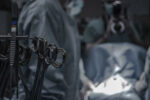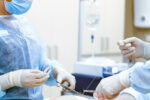Facts about breast augmentation surgery
- In a breast augmentation operation, breast implants are most often used to increase the size of the breasts or to restore the fullness of a breast that has been lost after weight loss or pregnancy
- The operation is mostly carried out privately
- In recent years, in some cases, breast enlargement operations have begun to be performed by using the person’s own fat (lipofilling). This requires that the person has sufficient fat deposits elsewhere, which are desired to be reduced
- Breast augmentation by transplanting your own fat often requires several operations to achieve a sufficient increase in volume. The end result is more unpredictable
- In certain cases, the best result of the operation is achieved by a combination of breast implants and the person’s own fat
- Breast augmentation is one of the most popular cosmetic surgery breasts operations in South Africa today.
- The breast implants used today are very durable. You can expect a shelf life of at least 10 years and probably considerably longer
What is the purpose of breast augmentation?
The purpose of the operation is to get bigger breasts or to regain a breast size that you had earlier in life or before pregnancy or major weight loss. This can be done by:
- Insert prostheses/implants, mostly silicone
- Transplanting some of one’s own fat from another place on the body into the breasts, so-called lipofilling
The two techniques can also be combined.
The silicone prostheses consist of a thicker, outer shell of silicone, which is either filled with saline or with a silicone gel or a combination of the two. There are many different types of breast implants.
Breast implants can be used to change the shape of the breasts and possibly to correct breast asymmetry. They are also widely used to recreate the breast (breast reconstruction) after illness such as breast cancer.
How does the operation take place?
During the operation, the surgeon makes an incision in the skin, most often in the furrow under the breast, but access at the edge of the nipple or in the armpit can also be used. The different approaches have advantages and disadvantages, which should be discussed and agreed with the surgeon before the operation.
A pocket is then created in the tissue on the chest wall where the implant is to be placed. The pocket may be located just below the mammary gland, below the muscular membrane of the pectoralis major muscle, or below the pectoralis major muscle.
How deep the implant is placed depends on the individual person’s skin quality, skin thickness and the quality of the breast tissue before the operation. Advantages and disadvantages are also discussed with the surgeon. Breast implants made of silicone, drop-shaped or hemispherical, are placed in the previously mentioned tissue pocket on the chest wall. The wounds are closed in layers in 2-3 layers.
It is possible to combine breast augmentation with breast lift. This often results in additional scarring on the chest, depending on the technique used. Extensive lifts often result in more/longer scars than smaller lifts.
The size of the implant is agreed between the woman and the plastic surgeon before the operation. You should not choose a size implant that does not suit your proportions. The operation lasts 1-2 hours and is mostly performed in full anesthetic.
Breast augmentation with own fat tissue
Breast augmentation with one’s own fat tissue is a newer technique. It has the advantage that you use your own tissue to enlarge the breasts with, and therefore do not get foreign bodies in the body, as implants do.
You typically have to be operated on in several rounds. In most cases, you cannot achieve quite as large an enlargement of the breasts as you can with the implants. The method is therefore most suitable for moderate breast enlargements.
If you are over 35-40 and need cosmetic breast surgery, you should have one mammograph before the operation. This is necessary to rule out that there are conditions in the chest that require treatment.
After the operation
After the operation, it is a good idea to use a sports bra or breast strap as support for the first 1 to 3 months. During this period, excessive lifting should be avoided. You can start working again after a week if it is office work or the like. You should not play sports for 4-6 weeks after the operation.
All breast surgeries leave scars to a greater or lesser extent. The scars should not be exposed to the sun or solarium for a year. This can cause pigment changes that can make the scars more visible. You should use a skin-friendly tape on the scars for the first 3 months.
Results
The breast implants used today are very durable. You can expect a shelf life of at least 10 years and probably considerably longer.
Some manufacturers offer a lifetime warranty, but it only covers the prosthesis and not the surgery. That is you can have the implant replaced (about 10% of the price), but not the entire operation. One must therefore anticipate later operations where the implant is replaced, and thus costs for the replacement.
Side effects
Pain
After the operation, the breasts will be sore and swollen. The pain is strongest if the implants are placed under the pectoralis major muscle. The discomfort will subside after approx. 10 days and probably disappear after three weeks.
Decreased sensation in the nipples
It is not unusual to have reduced sensation in the nipples for 1-2 months. In most people it normalizes after 1-3 months, but in some it can be permanent.
Breastfeeding?
The ability to breastfeed is usually not affected unless the incision is made at the nipple.
Implants and breast cancer?
Women with silicone implants do not have an increased risk of breast cancer or connective tissue diseases. However, a slightly increased risk for a rare form of lymphoma (BIA-ALCL) has been described.
Prostheses made of silicone can make it more difficult to detect malignant cancerous tumors in the breasts. The examination is more difficult to perform, especially if the implant is in front of the pectoral muscle. The result can also be more difficult to interpret. Ultrasound scanning can be a supplementary aid. The same applies to MR mammography.
Prosthetic edges
Noticeable prosthetic edges can also occur, especially if the implant lies above the pectoral muscle. It will appear as wrinkles or small bulges around the breasts if you are very thin, and especially when you are bent forward. A fat graft to the breast can in some cases reduce this tendency.
Possible complications
Complications are rare, but they do occur.
Capsular contracture
When an implant is placed under the breast, the body forms a capsule of connective tissue around the implant. This is a reaction against the foreign body and a natural scar tissue reaction.
In some women, this capsule shrinks and a hard and thick shell forms around the silicone prosthesis, so-called capsular contracture. The capsule formation can gradually lead to discomfort and severe discomfort. The breasts can change shape, become hard and sore.
The South African Plastic Surgery Breast Register (DPM) has shown that less than 2% are affected by such severe capsule formation that further surgery is required.
Other complications
- Leakage and cracks in the prosthesis may occur in rare cases
- Infection and bleeding around the silicone prosthesis may occur. DPM shows that approx. 1% develop an infection, the vast majority of which can be treated without further surgery. In some cases, the implant must be removed, and a new one can only be inserted after approx. 6 months
- Approx. 1% develop bleeding after the operation, and approx. half of these require surgery
- The scars after surgery may become thick and/or wide and itchy, which is rare
Less than 5% of all women with silicone implants develop a complication that requires surgery.






